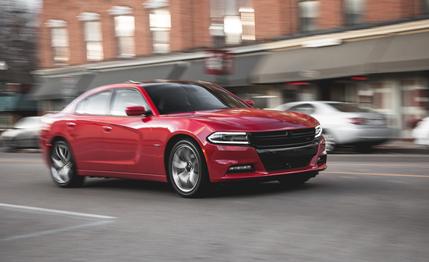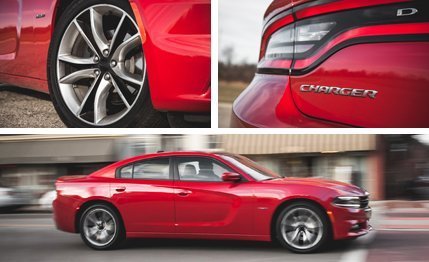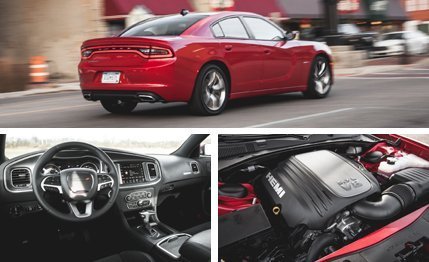 Instrumented Test
Instrumented Test
The new Dodge Charger R/T is like the high-school athlete whose brothers have gone on to star in college and pro ranks. Indeed, with the formidable Hellcat V-8 and the SRT 392 hogging the spotlight, the kid brother’s credentials pale. After all, the 392 packs 485 horsepower and the Hellcat lays a 707-horse smackdown, heady numbers that could make one perceive the R/T’s 5.7-liter Hemi V-8 as a little tame.
Do not be deceived. Unless you have an insatiable appetite for shredding tires, the 5.7’s output—370 horsepower, 395 lb-ft of torque—will satisfy most needs for speed. Okay, the R/T is governed to a mere 145 mph versus the Hellcat’s 204, but you’ll still reach the Chinese takeout place before they pack up your food, and 5.1 seconds to 60 mph will leave most sedans gasping for breath.
Surprisingly, given its mass, the R/T has a good dynamic résumé. The driver is aware of the substantial, two-plus-ton curb weight, but the Charger’s chassis tuning mitigates that number very well.
Thanks to a rigid unibody, the basic Charger R/T nicely manages yaw, pitch, and roll. But those who love to drive are advised to get the 29R Customer Preferred pack, which upgrades the car, as it did on our test example, to Road & Track spec. Doing so means a cornucopia of goodies including the Super Track Pak sport suspension; the Road & Track Performance Group with more aggressive throttle mapping, revised traction control (higher intervention threshold), heavy-duty brakes, 20-inch aluminum wheels, and sportier rubber (245/45 Goodyear Eagle RS-A2 all-season performance tires); and Dodge’s Performance Pages software, which allows the driver to track acceleration, cornering, and a variety of other numeric markers.

There’s a lot of other desirable stuff crammed into the 29R package, too, including nappa leather upholstery, ventilated front seats, heated rear seats (heated front chairs come on every R/T), a power tilt and telescope steering column, a heated steering wheel, power-adjustable pedals, and heated power mirrors, to hit a few high spots. At $3000 for all the foregoing equipment, it’s a must-have bargain collection.
Augmented by all the Track Pack goodies, the R/T dances even more remarkably well for a big car, the combination of quick (2.5 turns lock-to-lock), gratifyingly accurate electric power steering and firm suspension making it easy to place the car precisely where the driver wishes. And there’s enough grip to inspire confidence in very fast cornering.
It’s also very easy to develop affection for the eight-speed automatic. Shifts in the Charger aren’t quite as whap-whap quick as those delivered by some of the very best dual-clutch automatics, but one could call them deliberate, and in manual mode the transmission will hold the selected gear against redline—no autonomous upshifting.
The eight-speed is new for this year and slightly enhances EPA fuel economy versus last year’s five-speed unit, adding 1 mpg to the car’s city rating. That means 16 mpg in urban environs and 25 on the highway, on midgrade fuel, which is pretty good for a big V-8. We averaged 18 mpg in mixed driving. Would economy go up if the Hemi were fitted with direct fuel injection? Probably. But fuel economy isn’t a high priority for Hemi fans, nor for cars operating in this performance realm.
The car doesn’t have many demerits, and those it does have aren’t deal-breakers. We’ve already mentioned mass; cutting the curb weight would further improve handling and efficiency. The suspension tuning that gives the R/T its athletic reflexes can be a little stiff on gnarly pavement, and while grip—0.86 g—isn’t exactly a weak suit, it could be improved by a set of real summer performance tires.
Such tires would probably improve the braking performance, too, as 170 feet from 70 mph is long for a car with sports-sedan pretense. We detected no real fade in the system, but the pedal did begin to go a little soft after repeated hard stops.

Considered in standard trim and before its 2015 refresh, the Charger ranked behind mainstream sedan offerings like the Toyota Avalon and the Chevy Impala in our comparison test. But for the owner who wants a strong performance component in the everyday drive, the new R/T has the right stuff for an agreeable $33,990 starting MSRP.
Our test car got expensive quickly, however. In addition to the $3000 Preferred/R&T stuff (again, don’t leave the showroom without it), it had $6975 of additional options. These included $995 for Beats audio gear; $1795 for the Technology Group (rain-sensing wipers, auto high beams, and safety nannies); $295 for Driver Confidence equipment (blind-spot and cross-path warning, exterior puddle lamps); and $695 for navigation, infotainment goodies, and a backup camera. Our car also was fitted with a power sunroof ($1195), Redline Red paint ($500), and a black-painted roof ($1500).
The grand total came to $43,965. That’s more than the cheap-speed $40,990 R/T Scat Pack, although still well shy of the $48,380 Charger SRT 392. (The wild and wooly Hellcat opens at $64,990.) In any case, there do seem to be some opportunities for whittling. Okay, the red paint is probably important, as it emphasizes the aggressive styling. On the other hand, do you really need the safety technology, puddle lamps, or the black roof?
Options notwithstanding, this Charger figures as an underappreciated performance bargain in a full-size sedan. It’s everyday useful and ready to rock every day.